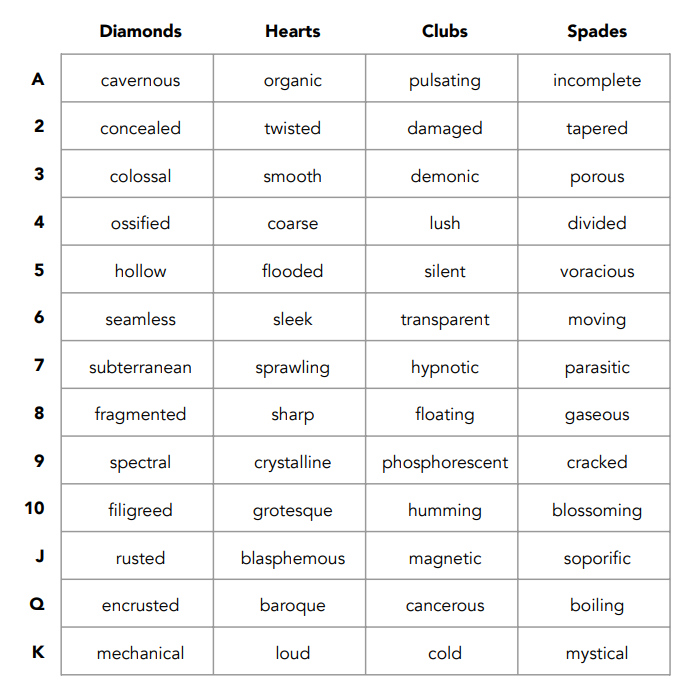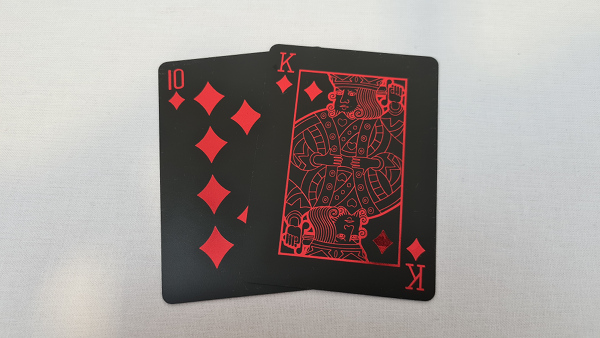Chiron's Doom review
Chiron’s Doom is a storytelling game for 1 to 3 players by Nick Bate. It gives the players the task of telling the story of a group of brave or foolish explorers on an expedition into a structure of unknown purpose. Unfortunately the expedition is not going to go well…
The only components required for the game are the rules, a deck of standard playing cards, and some way to record the story being told. If you haven’t played storytelling games before then they might be a big mental shift for you, especially if you’re used to much more crunchy games. This type of game is all about the fiction and everything comes from the player’s imagination. You could give two players identical decks to play from and they would end up with two completely different stories. My advice when playing Chiron’s Doom, as with most storytelling games, is to take it at your own pace and put some thought into the situations you’re describing. More than with most types of game, you get out what you put in.
So let’s talk about how the game is played. The first step in playing Chiron’s Doom is to establish some descriptors of the structure, or monument in game terms, from a large table. These can be randomly selected by drawing cards or chosen by the players if they already have an image of the monument in mind. These cover the expected things like cavernous, flooded, or damaged, but also things that will need some interpretation like fragmented, spectral, or parasitic. Next the players generate three explorers that make up the expedition. Again, there is a table to draw cards against, but there’s nothing stopping you picking options that catch your eye. The options given cover quite a range, from “a veteran of many battles” to “a priest of a forgotten god” to “a trader in relics and obscurities”. The players answer a question from a pre-defined list for each explorer, giving a bit of insight into who they are.
Once the monument and the explorers have been figured out, the players split the playing cards into several decks. These are the expedition decks, which contains six Diamond cards plus the 2 of each other suit, and three disaster decks, one for each other suit containing four cards each. Each deck contains a King, which we’ll talk about in a moment.
The basic mechanic is of drawing playing cards from the expedition deck to provide prompts that the players weave in to the story they’re telling. The prompts are in four categories corresponding to the four card suits: Secrets Revealed (e.g. “You succeed a dismantling a part of the monument. What do you learn?”), Tensions Rise (e.g. “A disagreement comes to blows. Who wins? Who loses? What does this mean for the expedition?”), The Monument Resists (e.g. “The monument’s avatars attack you. What form do they take? How do you survive?”), and The Outside World Intrudes (e.g. “A new group sets up nearby. Who are they? How do they disrupt your expedition?”).
Once all the Diamonds in the expedition deck are drawn the goal has been reached and the game is complete. Simple. There’s a couple of wrinkles though. Firstly, whenever a player draws a 2 of Hearts, Clubs, or Spades they have to shuffle the appropriate disaster deck into the expedition deck. The prompts for the disaster deck cards tend not to be good news for the explorers. Secondly, remember those Kings? Each time a player draws a King an explorer dies. Each suit has a different prompt for why the death happens, but there’s no way around it—you’re one explorer down. Raises the stakes a little, right? And yes, the presence of the King of Diamonds in the expedition deck does mean that even the best possible play has a non-zero body count. In the worst case you can have a total of four Kings making their way into the expedition deck. I don’t need to be an expert in stochastic simulation to know that the maths on that situation is bad news.
As you can tell, this isn’t a game that goes easy on the explorers, so it’s best not to get too attached to them. Unfortunately, my first playthrough began with me giving them names, backstories, and choosing artwork for them, so I was attached to them before it even started. It dawned on me that I should probably figure out a rough order that it would make sense to kill them off in just so I was prepared for the worst case, but the answer was that I didn’t want to kill any of them. I wanted to take them into a different game system where I could keep them safe. Maybe have a pint in a local space bar and wait for this whole monument business to blow over. Alas, I was playing Chiron’s Doom and the cards didn’t care about all that. Maybe I can run an alternate universe game in a different system at some point…
Anyway, suffice it to say that the game did not go easy on me and it made my characters regret ever entering the monument, tempered only by me pulling some of my punches because I wasn’t quite ready to be as brutal as the game wanted me to be. The tension when turning over a new card and the sometimes horrible decisions it forces you to make are fundamentally what this game is about. If you’re looking for a game that is unrelenting and rigged against you but puts the onus on you to decide in what way things are going badly then this might be one to look at. There’s definitely something about it that immediately hooked me and maybe it’ll hook you too.
Chiron’s Doom, along with Nick’s other games, can be found on Itch.io and his upcoming game Stealing The Throne, about performing a heist to steal a thousand year old mech, is on Kickstarter where it has already met its goal. The Kickstarter ends on the 23rd February.


